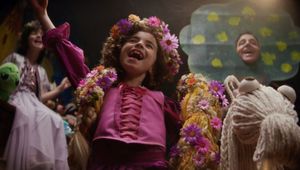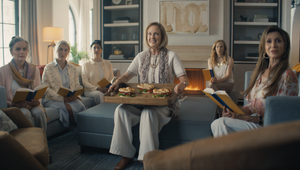
BlubBlub’s Big Adventure: Behind Disney’s Most Unexpected Holiday Star

This holiday season, Disney’s done it again, delivering a heartwarming Christmas ad that feels equal parts classic and utterly unexpected. ‘The Boy & The Octopus’, a whimsical tale of friendship, curiosity, and festive dreams, brings an unlikely star to the forefront: BlubBlub, a wide-eyed, CGI octopus with big aspirations.
Directed by the brilliant Taika Waititi (‘Thor: Ragnarok’, ‘Jojo Rabbit’), the short film has all the hallmarks of a Disney masterpiece – an emotional story, spot-on music, and that signature touch of magic. But crafting a story about an octopus falling in love with Christmas didn’t come without its challenges.
From bringing BlubBlub to life as a charming, relatable character, to seamlessly blending breathtaking underwater visuals with live-action scenes, the team at adam&eveDDB and Untold Studios repeatedly pushed the boundaries of creativity and technical precision. But how exactly did they do that?
Creative director at Untold Studios Adam Droy gives LBB’s Zoe Antonov a closer look at how the team of creative wizards turned ‘Part of Your World’ into the heartbeat of a new festive classic, and gives the rundown on how they created the unforgettable BlubBlub.
LBB> The octopus character is so central to this story. What were the key challenges in creating a CGI octopus that feels relatable, and how did you overcome them?
Adam> As with all our character work, we start by establishing who BlubBlub is and a set of rules to work in. We wanted to stay true to a real octopus as much as possible but leaning more into design features to make him as adorable and endearing as possible. Never could his movements or appearance be creepy or alien like!
Taika was keen for the octopus to never look like he was controlling the boy or attacking him - easier said than done with so many tentacles! Our initial go-to was for the octopus to be moving all around the boy’s head, but this looked too ‘squirmy’ with more charm coming from BlubBlub staying more central and engaged with the world around him.
One huge challenge was BlubBlub’s performance. How do we show his range of emotions without the key facial features we are used to. He doesn’t have a mouth, nose or even eyebrows! We relied heavily on overall body shape along with expressive eyes to do a lot of the heavy lifting. We looked to develop subtle pupil dilations or head tilts to help portray how BlubBlub felt in a particular scene. We had a whole team working on just the look of his eyes! Crafting the exact level of reflection and highlights could really bring life into the performance.
LBB> Disney is known for creating characters with enduring emotional appeal. Can you share some of the processes or references you used to bring out BlubBlub’s charm?
Adam> The backbone of Blub Blub’s charm is really establishing his character early on. We knew he needed to be the same sort of age as the boy, so a younger octopus, so they could realistically be friends (it’s believable). Being younger also allows us to lean into some visual characteristics such as larger eyes and a slightly bigger head to tentacles ratio, this always looks cute. Alongside that we wanted him to be plucky, enthusiastic yet sometimes naive and cautious.
The benefit of a four-minute edit was that we could really develop the emotional arc of BlubBlub. As a plucky, excited yet naive young octopus, he goes on a journey of intrigue, nervousness, awe, vulnerability and friendship. It was amazing to discover and see his character develop both as we worked on the film and watch the story unfold.

LBB> How did you work with the team at adam&eveDDB to ensure that the CGI integrated seamlessly with the live-action scenes?
Adam> On a film that relies heavily on CG or VFX we often do quite a detailed previz of each shot, based off of storyboards. This gives everyone involved a very good sense of timing and pace of the film. In this case, however, we decided to focus all of the preproduction previz time on more of BlubBlub’s performance and character. We looked at all of the key story moments of the script and crafted animation that we thought could work well with for the story point. We opened it up to our talented animation team – asking them what they thought would be cool for BlubBlub to do – we got some amazing, creative results that way, lots of which we weaved into the final film! Then on set when shooting the live action, we had a bit of an inspiration cheat sheet. “Maybe he could do this sort of action, or have this sort of look here.” Riffing off different vinettes of animation we had created rather than being too technical in the previz.
We find the best way to integrate a CG character with live action is for things in the live action world to appear like they are affected by the CG character. One perfect example is during the plan making scene – on set we puppeteered pencils and choreographed the boy’s action based on a piece of animation we had done in previz. We then did CG replicas of pencils and matched the movements to make it look like the boy was passing objects to the octopus.

On set we took lots of the usual lighting reference such as chrome and grey balls as reference, as well as 360 photography to be able to mimic the on set lighting as accurately as possible when back in CG. Working alongside the art department we also 3D printed and molded an early interaction of BlubBlub which had fully articulated tentacles which we could attach to the boy's head. This gave us an excellent reference of how to seamlessly integrate Blub Blub into the shot at a later stage. It was also super helpful to give the actor both a visual and something physical to react to.
LBB> The underwater sequences are stunning – what VFX techniques did you use to create the realistic, yet magical, underwater world?
Adam> Our initial plan was to shoot the underwater scenes in the sea whilst on location in Majorca. As it happened on the day the water was a little bit rougher than anticipated, meaning the plates that were shot were a bit cloudy. We decided to combine both plates, stock and DMP footage along with adding CG bubbles and particles in the water. We were mindful to keep the look of the underwater scenes realistic to what could plausibly be found at the depths the boy was swimming. Not too deep, yet with some nice geography to make a pleasing shot. We added caustic light shining through the water which lights BlubBlub to also help tie him into the shot in a realistic way.
LBB> Could you walk us through the process of creating the 'sushi horror' scenes? How did you approach balancing humour and the octopus's sense of surprise or fear?
Adam> The honest answer is – we created a lot of options! We explored many routes. Should BlubBlub see the sushi chop and be scared, or should he be unphased as this is new to him? Should the boy cover his eyes before he even notices? Should he lean in to try to learn more, or recoil in fear? In the end we found the right balance of BlubBlub just noticing the chop and being both shocked and intrigued in equal measures before the boy steers him away – like any good friend would!

LBB> 'Part of Your World' from The Little Mermaid is an iconic Disney song with a lot of emotional weight. How did the music inform your approach to the VFX, especially in scenes highlighting the octopus' dreams and curiosity?
Adam> It’s such a great choice of music! It complements the story and visuals so well. We really wanted to crack up the emotional ‘feels’ in key moments such as the Christmas tree goodbye moment. We thought that if the visual alone made you tear up, paired with the amazing music the audience wouldn’t have a chance at holding back the tears! Very subtle things in BlubBlub’s performance across the film, like a quivering eyelid, or timid eye dart to the boy, or a little teary waterline on BlubBlub along with very intentional lighting of the eyes to place little pings, really added emotion to the shots. Even little techniques like a slow zoom into Blub would add a real connection to the viewer and our little octopus.
It’s worth noting too that as a group we discussed the “Blub Blub” sound at great lengths. We would animate how the sound could be made by BlubBlub letting the visuals inform the sound and then going full circle to animating to what the sound was like. It was a real ping pong approach, but it worked. There was no rule book or reference of what an octopus saying ‘hello’ sounded like!
LBB> Are there any particular technical or creative innovations that Untold Studios introduced for this campaign?
Adam> It’s safe to say this was one of our most complex and challenging creatures to date!
Crafting such a complex character as BlubBlub was a monumental challenge and required us to RND new ways of working. When we read the script we knew we would have to be able to achieve everything a real octopus can do and more! We developed a skin system that allowed us full dynamic and procedural control to change colour, pattern and shape of the cells of the BlubBlub’s skin mimicking that of a real octopus. Importantly we used this to compliment the story - when BlubBlub was cold he shivers and white dots flow down his tentacles or when he takes on the appearance of the Christmas decoration to continue his discovery of the world.
Funnily enough, our biggest ‘how do we do that?!’ moment initially wasn’t related to making a fully photorealistic octopus but directed to integrating an octopus onto the head and hair of the boy. We created three whole unique grooms of hair, wet, dry and under the hat, based off of a full 360 scan. Once we had this BlubBlub could move anywhere on the boy's head and we could realistically simulate all the hairs he interacted with.
One feature that makes BlubBlub unique is that he has a thin film that covers his entire body – inspired by what is found in nature with real octopuses. We named this the ‘clear coat’. It’s a secondary layer of super thin skin that covers his whole body and bridges gaps in his underlying body giving really detailed and delicate reflections over him. This technique gave us a huge range of control allowing us to dial in exactly how wet or dry Blub Blub might feel in certain situations.
LBB> Can you tell us about any specific Easter eggs or visual nods in the VFX that Disney fans might enjoy finding?
Adam> Oh that would be telling! As with all easter eggs, they are best found by the viewer!















